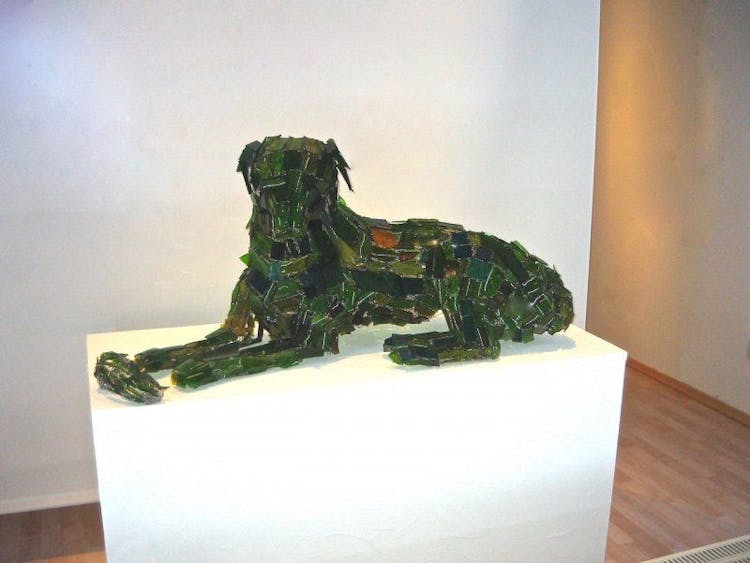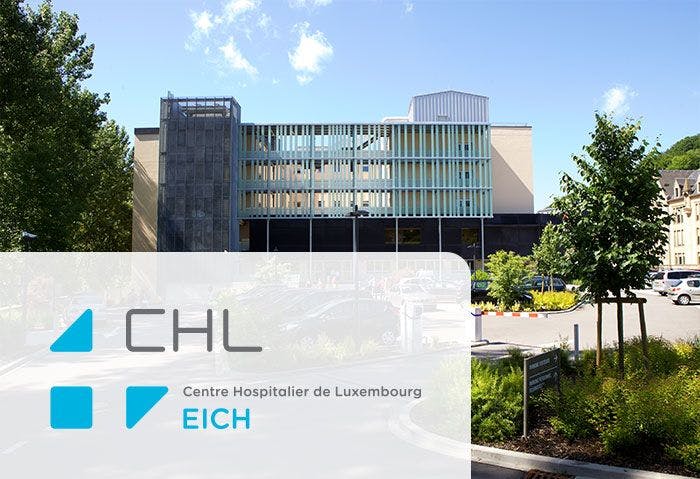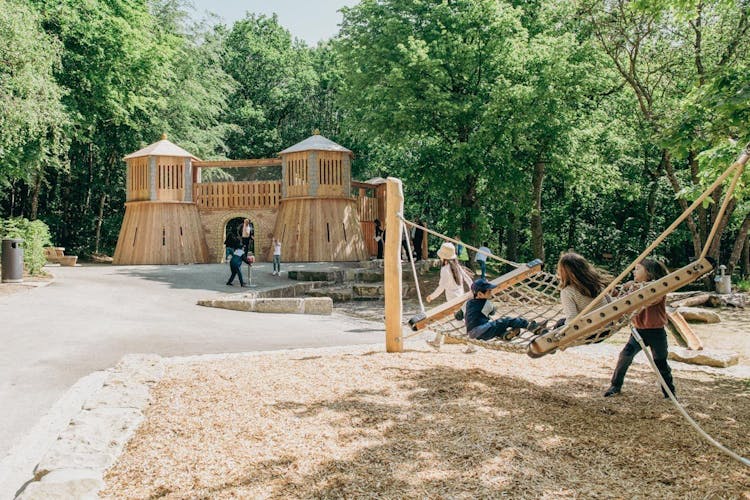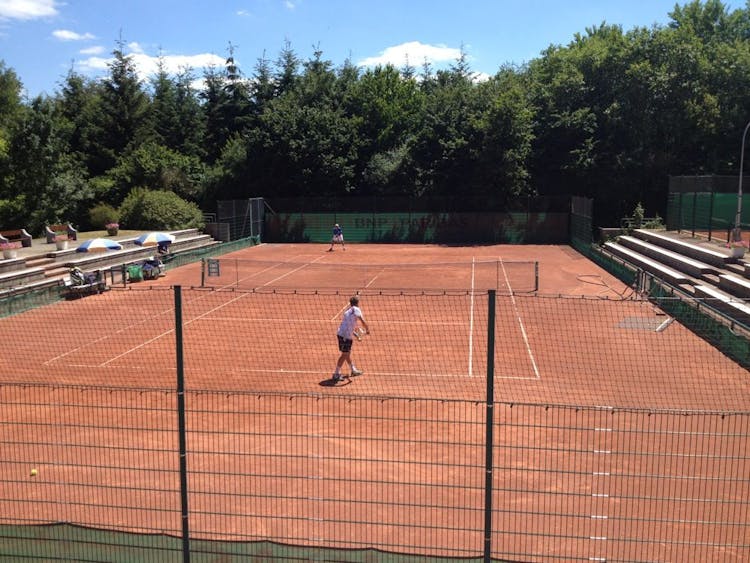
Muhlenbach: spacious green neighborhood in Luxembourg City
In this article, we embark on a journey through the historical corridors, explore the vibrant population, weigh the pros and cons of residing in Muhlenbach, dissect the area's transport accessibility, take a closer look at its infrastructure, and navigate the nuances of renting and buying real estate.
Nestled on the northern border of Luxembourg's capital, Muhlenbach stands as a tranquil residential haven, bordered to the east by Beggen and Eich, to the south by Limpertberg, and to the west by Rollingergrund/Belair-Nord. The verdant expanse of Bambësch Forest to the north graces the neighborhood with lush greenery, creating a serene environment with a sparse population.
General characteristics of Muhlenbach
Primarily residential, Muhlenbach epitomizes a high quality of life, offering an idyllic setting for family strolls and relaxation. With an expansive footprint, the majority of Muhlenbach is adorned with green spaces, leaving the built-up areas modest and predominantly residential. In terms of infrastructure, the neighborhood may be considered somewhat lacking, devoid of elementary schools and with limited commercial establishments or supermarkets. However, this deficiency is counterbalanced by the proximity of Limpertsberg, a neighboring district with many commercial and cultural venues and renowned for its abundant educational institutions.
Muhlenbach's allure lies in its peaceful ambiance, an escape from the hustle and bustle of the city center, making it an ideal retreat for those who appreciate a quieter lifestyle.
Population of Muhlenbach neighborhood
As of January 1, 2024, Muhlenbach's population stood at 2,482 individuals, comprising 1.87% of the capital's inhabitants. Notably one of the less densely populated neighborhoods, Muhlenbach boasts a foreign resident percentage of 68.86%, closely aligning with the citywide average of 70.44%.
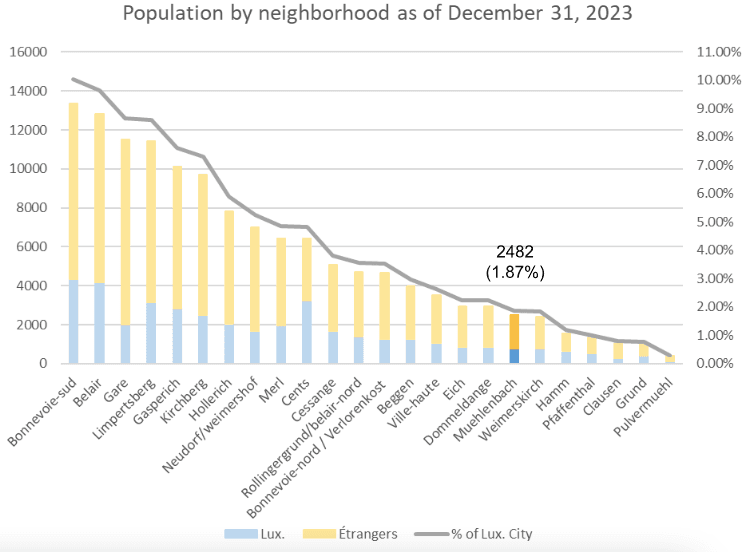
Transport accessibility
Muhlenbach, with its expansive layout, predominantly unfolds its residential canvas in the southern reaches. As we explore the various modes of transportation, we've based our travel times on this residential area.




You can check the route of each bus line in detail on the interactive map provided by the city of Luxembourg and get detailed instructions to get from one point to another on their route planner page.
Renting and buying real estate
Muhlenbach presents an appealing real estate landscape, with buying prices at 10,905 euros/m², notably lower than the city's average of 12,243 euros/m².
Rental rates, while not as favorable, remain reasonable at 30.01 euros/m², closely aligning with the capital's average of 30.72 euros/m². The neighborhood provides a financially attractive option for those considering both buying and renting, contributing to its allure as a residential destination.
For purchase prices stand at
For renting prices stand at
Applications, search and profound advice in our guide to rent in Luxembourg

Infrastructure of the neighborhood
Despite its small size, Muhlenbach stands out for its limited infrastructure in cultural, educational, and commercial aspects, lacking in theaters, schools, and supermarkets. However, this compact neighborhood shines in its provision of sports facilities, notably near the Bambesch playground. The sports center hosts tennis courts, a football field, and the Flèche d'Or shooting range. Additionally, the remarkable Bambesch playground, nestled in a green oasis, offers a vibrant space for families. Muhlenbach, though modest in scale, paints a diverse canvas of recreational offerings.
If you're considering making Luxembourg your new home, we encourage you to explore our range of articles that look in depth at the different city communes and neighborhoods.
Pros and cons of living in Muhlenbach
A notable advantage lies in the adjacency to Limpertsberg, offering a myriad of establishments, commercial, cultural, and educational. The district is an educational haven with many primary and secondary schools and even a campus of the University of Luxembourg. Real estate prices for purchase are also a positive point, being considerably below the city average.
However, drawbacks include the dearth of commercial and cultural infrastructure, a scarcity of primary schools, and the absence of supermarkets, necessitating trips to neighboring areas for supplies. While easily accessible by car, those reliant on public transport may find the limited bus lines and extended travel times somewhat inconvenient.
What can you find in this neighborhood of Luxembourg City
Muhlenbach unfolds as an inviting residential haven, boasting a serene and family-friendly ambiance. The proximity of the Bambësch Forest to the north enhances the appeal, providing enchanting natural spaces and popular trails embraced by both district and city residents.
Muhlenbach faces a stark lack of educational institutions, lacking both primary and secondary schools, as well as public childcare centers. The sole educational facility is the private Bambesch Kids Nursery.
However, neighboring Limpertsberg provides a stark contrast, boasting an extensive educational landscape with numerous primary and secondary schools, including a campus of the University of Luxembourg. Additionally, a nearby public primary school in Eich, the Eich Public Primary School, located within a 5 to 15-minute walk, offers an alternative for residents seeking educational options.
Bambesch Kids Nursery
Address: 82 Rue des Sept-Arpents, Muhlenbach Luxembourg, Phone: (+352) 27 99 46 76, Website: bambesch-kids.lu
Cultural offerings in Muhlenbach are notably sparse, lacking theaters, concert halls, or a public event venue common in most neighborhoods. However, a noteworthy exception is the Jean Claude Chapelotte Galerie, an art gallery specializing in contemporary glass artists. This unique space collaborates with private collectors, museums, and businesses to curate collections of glass sculptures and installations, providing a distinctive cultural touch within the neighborhood.
Learn more about Luxembourg's culture and traditions in our special guide.
Jean Claude Chapelotte Galerie
Address: 7 Rue Jean-Pierre Huberty, Muhlenbach Luxembourg, Phone: (+352) 6 21 17 45 13, Website: jcc.lu
While Muhlenbach itself lacks hospital facilities, residents benefit from the proximity of the CHL Eich in the neighboring district of Eich. Accessible by car in under 5 minutes or by foot, ranging from 10 to 25 minutes depending on the starting point in Muhlenbach.
This center has a rich history dating back to 1873. Initially founded as a hospice and orphanage, it evolved into the Clinique Muhlenbach and later merged with the Centre Hospitalier de Luxembourg (CHL) in 2004.
The CHL comprises four major establishments: CHL Centre, CHL Maternity, CHL KannerKlinik, and CHL Muhlenbach. While the first three are clustered in Rollingergrund-Belair-Nord on Route d’Arlon, the Muhlenbach center stands alone. Historically focused on ophthalmology, otolaryngology, and orthopedics, it now offers versatile internal medicine, sports medicine, preventive care, acute geriatrics, and palliative services.
If the specialized care department sought is not available at CHL Muhlenbach, residents can easily access other prominent healthcare facilities in the city. Here are the addresses and distances to some of the city's major hospitals:
- Clinique Zitha: 20-30 Rue d'Anvers (average time: by car — 15 minutes; bus — 30-35 minutes);
- Kirchberg Hospital: 9 Rue Edward Steichen (average time: by car — 15 minutes; bus — 30-45 minutes);
- Centre Hospitalier de Luxembourg: 4 Rue Nicolas Ernest Barblé (average time: by car — 10 minutes; bus — 20-25 minutes).
For immediate pharmaceutical needs, Hübscher Sophie Pharmacy at 50 Rue de Muhlenbach serves the community.
While Muhlenbach may lack extensive infrastructure, its natural surroundings and green spaces stand out as a prominent feature. The neighborhood offers various children's play areas, with one to the west on Rue Albert Unden, another to the east at 119 Rue de Mühlenbach, and a central one adjacent to the church. Notably, the Bambesch playground, located further north, takes the spotlight.
Bambesch is an expansive forest playground set amidst a captivating green landscape, featuring towering trees and breathtaking nature. This playground boasts impressive slides, swings, sandpits, zip lines, wooden courses, and even a water play area. Xylophones inside a wooden castle allow children to create music and have fun. Parents can relax on benches or picnic areas while watching their kids play.
The playground is divided into sections catering to different age groups, each thematically inspired by historical landmarks in the city, such as the Bock promontory, castle bridge, hollow tooth, three towers, fortress wall, and the Alzette River. It's an extraordinary play haven, a paradise of fun for children.
In addition to the Bambesch forest playground, the Bambesch wooded area offers numerous walking trails, providing opportunities for residents to connect with nature and explore the scenic surroundings.
Unlike other domains like culture or education, Muhlenbach boasts a well-equipped sports infrastructure. Adjacent to the Bambesch playground, a sizable sports center offers a multitude of facilities. Notably, Tennis Spora operates several tennis courts, complemented by the Mathias Mamer football field. The Flèche d'Or shooting range provides enthusiasts with opportunities for courses and tournaments.
Within the Bambesch Sports Center, the Back To Sport Association finds its home. Established in 2016, Back to Sport aims to bring together both adults and children with physical disabilities around sports. Individuals with reduced mobility (PMR) are guided by a team of passionate volunteers, all committed to promoting sports as a means of personal reintegration.
Unlike other domains like culture or education, Muhlenbach boasts a well-equipped sports infrastructure. Adjacent to the Bambesch playground, a sizable sports center offers a multitude of facilities. Notably, Tennis Spora operates several tennis courts, complemented by the Mathias Mamer football field. The Flèche d'Or shooting range provides enthusiasts with opportunities for courses and tournaments.
Within the Bambesch Sports Center, the Back To Sport Association finds its home. Established in 2016, Back to Sport aims to bring together both adults and children with physical disabilities around sports. Individuals with reduced mobility (PMR) are guided by a team of passionate volunteers, all committed to promoting sports as a means of personal reintegration.
Muhlenbach is characterized by a limited number of shops, lacking supermarkets within its bounds. Residents often need to venture into adjacent neighborhoods for their grocery needs. Similarly, the dining scene is modest, with notable mentions including Café Bambesch situated at the western extremity of the neighborhood.
Historical overview
Muhlenbach, aptly named after the stream that courses through its heart, has a rich historical tapestry woven around the mills that flourished in its vicinity. In the 13th century, a flour mill marked the inception, while the Jesuits, in the early 18th century, added a paper mill, crafting Luxembourg's inaugural paper.
19th century
Modern times
Frequently Asked Questions (FAQ)
What are the main features of Muhlenbach's residential environment?
Muhlenbach's residential charm lies in its serene ambiance and family-friendly atmosphere. The neighborhood predominantly unfolds in the southern reaches, surrounded by the lush Bambësch Forest to the north. With limited commercial intrusion, it offers a peaceful haven for families seeking a tranquil living experience.
What are the pros and cons of living in Muhlenbach?
Pros include a high quality of life, proximity to the scenic Bambësch Forest, and adjacency to well-equipped Limpertsberg. However, the cons encompass a lack of commercial and cultural infrastructure, scarcity of primary schools, and the absence of supermarkets, necessitating trips to neighboring areas for supplies.
What sports infrastructure does Muhlenbach offer?
Muhlenbach boasts a well-equipped sports scene, particularly near the Bambesch playground. Facilities include tennis courts supporting the Tennis Spora school, the Mathias Mamer football field, and the Flèche d'Or shooting range. Additionally, the Bambesch Sports Center hosts the Back To Sport Association, promoting sports for individuals with physical disabilities.
Are there parks, nature places, and playgrounds in Muhlenbach?
Yes, Muhlenbach offers green spaces and recreational areas. Notably, the Bambesch playground is a standout feature, nestled in a forested landscape. It features impressive play structures, thematic sections, and walking trails, providing a delightful space for families and nature enthusiasts.
What are the real estate prices like for buying and renting in Muhlenbach?
Muhlenbach presents an attractive real estate landscape. Buying prices stand at 10,905 euros/m², notably lower than the city's average of 12,089 euros /m². Rental rates are reasonable at 30.01 euros/m², aligning closely with the capital's average of 30.53 euros/m².
Source: fr.wikipedia.org, www.vdl.lu, www.justarrived.lu, www.luxembourg-city.com, www.backtosport.lu, www.flechedor.lu, tennisspora.lu, www.immotop.lu
We took photos from these sources: chl.lu, Jean Claude Chapelotte Galerie website, Bambesch Kids Website, Ville de Luxembourg website, Club Spora website

